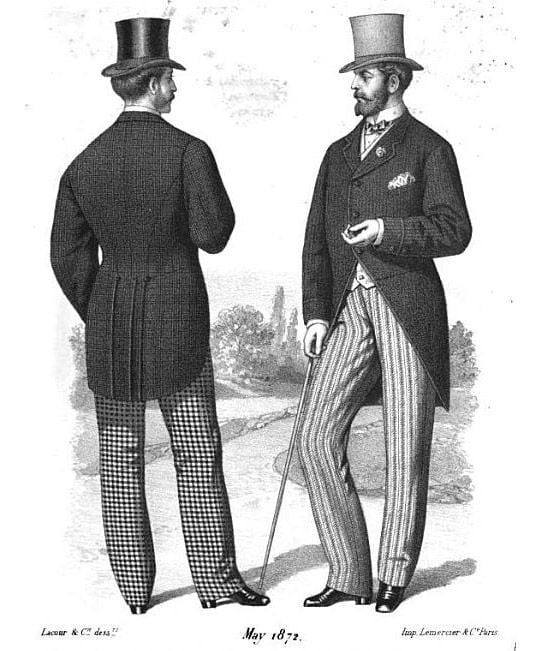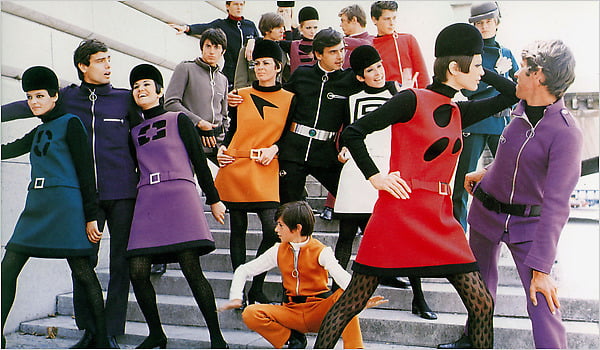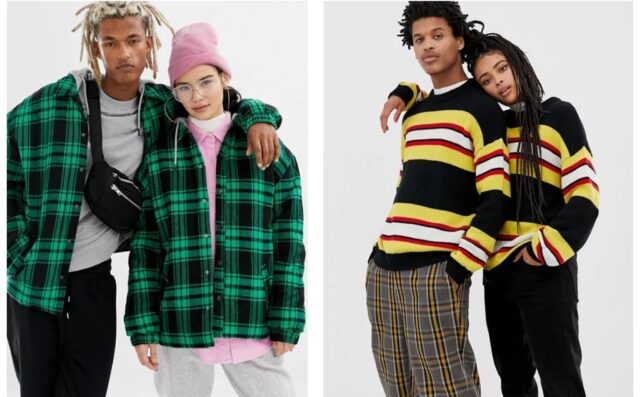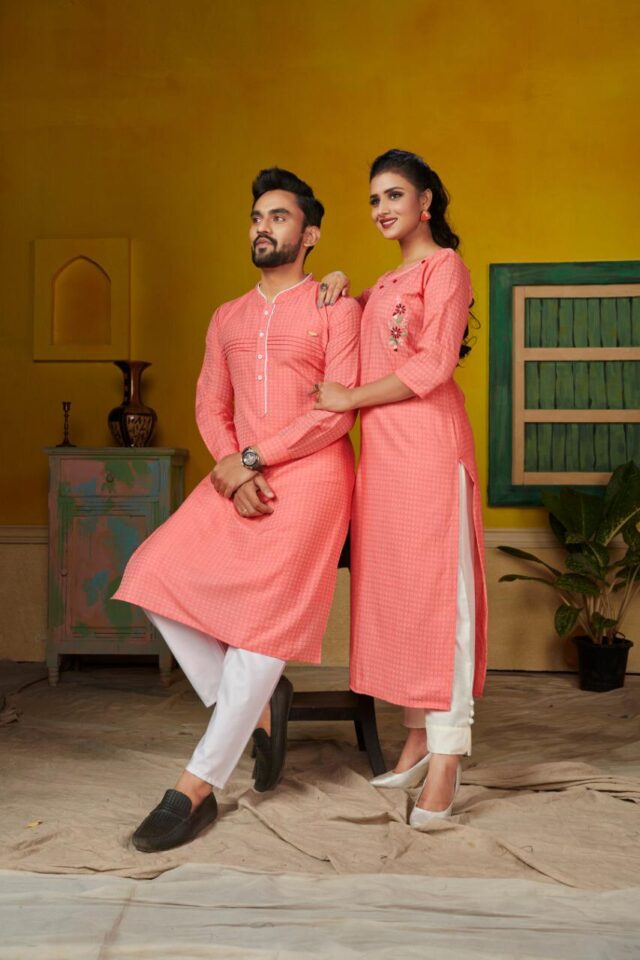Earlier, the idea of clothes not having a gender was rather radical, but now the gender associated lines related to clothing are blurring. Now, the idea of clothes having no gender is becoming mainstream in our society.
But gender-neutral clothing is not an invention of the twenty-first century, it has been around for centuries now. The Greeks, Scotts, Australian Aboriginals, Red Indians, Indians, their standard attire both for men and women typically consisted of two pieces of clothing, draped around the body- a tunic and a cloak. Considering history, clothing was more or less gendered in different eras and places.
Effects Of The Industrial Revolution On Clothing
During the industrial revolution clothing in the West became strictly gender oriented. One clear example is, skirts have entirely disappeared from men’s wardrobes. In fact, up until the 19th century, the skirt wasn’t a garment that only women were supposed to wear.
On the contrary, it had been a part of the male outfit in both Medieval and Renaissance Europe. For example, in 16th and 17th century Europe, the noblemen’s go-to attire included hoses, sometimes codpieces, and skirt-like voluminous puffy breeches. During the 19th century, even small boys were dressed in skirts, earlier, regardless of gender, children were dressed in skirts and lavish gowns.

Beginning Of The Genderless Fashion
In 1968, designers such as Pierre Cardin, Andre Courreges, Paco Rabanne and Mary Quant started a clothing line called the “Space Age”. It consisted of sleek and simple silhouettes with bold graphic patterns, new, synthetic fabrics that had no historical gender associations.
And women burned their bras symbolically. U.S. department stores created special sections for unisex fashions, though most of them had closed by 1969. But their impact could be felt for a decade afterwards in “his-n-hers” clothing, promoted in cutesy ads, catalogue spreads, and sewing patterns.
“The difference between avant-garde unisex and the later version,” Paoletti argues, “is the distinction between boundary-defying designs, often modelled by androgynous-looking models, and a less threatening variation, worn by attractive heterosexual couples.” After this many designers like David Bowie, Prince, and Grace Jones defied gender norms with their clothing choices.

Nowadays, more and more people seem to want to free themselves from gender roles and norms, and this attitude influences the current fashion scene, which is becoming increasingly more gender-neutral.
Read More: In Pics: Indian Fashion Labels That Have Championed Gender Neutrality
Fashion Houses Bringing About The Necessary Changes
Fashion houses have been blurring the line between menswear and womenswear for decades. But now we can witness it every day, as society’s perception of gender is visibly shifting.
The British Fashion Council (BFC) is also trying to keep up with this shifting fashion scene. Recently they released a statement announcing that for the next twelve months, London Fashion Weeks will merge womenswear and menswear into one gender-neutral platform, to allow designers greater flexibility.
London Fashion Week won’t be separated along binary lines for the first time in its 37 year history, reflecting the fashion industry’s increasing willingness to get over the gender binary.

Nowadays celebrities seem to love gender-neutral fashion and some celebrities and influencers are famous owing to their gender-norm-defying-fashion sense. It’s wonderful to see how society has embraced gender-neutral fashion and it’s encouraging people to be more expressive about their sexuality as they do not have to conform themselves to gender-conforming trends.
The new popular and scientific interest in bisexuality was liberating for homosexual men, women and trans men and women, offering them a culturally acceptable alternative to their closet.
Fashion gave them a free space to breathe. It was liberating for fashion, as well. Everyone could finally accept their gender and we have to remember that every one of us is a different gender and yes, you heard me right. Remember that and say it aloud. So everyone is a little bit of each sex and clothing did not have to proclaim one or the other as loudly as it used to.
The Gen Z And Gender Neutral Fashion
Unisex clothing aimed to minimize gender differences. The unisex movement may have made women’s clothes more masculine, but it never made them unfeminine; furthermore, “attempts to feminize men’s appearance turned out to be particularly short-lived,” Paoletti notes.
Now even market trends are shifting and there is an apparent 52% rise in demand for “genderless” and “gender-neutral” fashion. Especially among Generation Z, they are much onto the genderless fashion. They strongly oppose the idea of clothes defining their gender and gender binary shopping. Only 44% of Generation Z members participate in shopping for gender defined clothing.

In 1966, Yves Saint Laurent launched a tuxedo line for women called “Le Smoking”, he reinterpreted the mannish silhouette in gangster pinstripes and safari khaki. Roy Halston Frowick rose to fame after his ubiquitous Ultrasuede shirtdress ( a modern, feminine twist on a man’s shirt) which became popular among American women during the mid-1970s.
As the current FIT Museum exhibition Yves Saint Laurent and Halston: Fashioning the Seventies illustrates, the designers weren’t merely dressing women in menswear; they were dressing them as themselves, in classic pieces that reflected their own, subtly androgynous wardrobes.
The exhibition catalogue argues that this “slick and functional style” associated with the international jet set was equally appealing to young, working women: not just trousers but pea coats, dress shirts, and blazers became female wardrobe staples.

Gender Neutral Fashion In India
Indian costumes and clothing have large visibility of genderless fashion. Starting from ‘kurtas’ to ‘angrakhas’, Indian garments have always had elements of gender fluidity. Even in old sculptures or paintings, we see men and women both were generally bare-chested and wrapped a piece of clothing around their loins.
Even dhotis, pyjamas, kurtas and lungis are still worn by both men and women. Our gods and goddesses also have a similar style of clothing, ornamented with heavy jewellery.

Arnav Malhotra, owner of No Grey Area says, “Our aesthetic goes beyond just oversized clothing. Our resort shirts, printed pants, bomber jackets and tees are being worn across genders,”. His biggest observation is the average Gen-Z male’s willingness to experiment.
“Women have been wearing menswear for years. But it’s the men who are comfortable going beyond just the masculine now. It’s a testament to the changing gender norms in society, particularly among the younger generation.”
The Lines Are Blurry And We Love It!
The concepts of masculinity and femininity no longer define the clothing that people wear. Both men and women are choosing to define themselves on their own terms rather than bound to a specific idea, culture, class or individuality.
Fashion is ever-evolving and ever-changing, we cannot possibly compartmentalise it. Fashion is an expression of one’s self, it lets one be themself, unapologetically. As we look around we realise that now the gender fashion isn’t as clear as it used to be once.
Now the society is more open and is accepting people to express their gender through clothing and they don’t have to wear clothes pertaining only to their biologically assigned sexuality. Gender has slowly bled into an acceptable fashion. The concepts of masculinity and femininity no longer define the clothing people wear.
Gender fluidity and gender-neutral fashion isn’t just a phase in fashion, it’s here to stay and rather evolving. And not only is it a blessing for society but it’s definitely a blessing for fashion.
Image Credits: Google Images
Sources: Luxider, The Fashion Globe, The Atlantic
Connect with the blogger: @GhoshSohinee
This post is tagged under: gender, gender neutral, fashion, fashion fluidity, evolving, ever changing fashion fashion trend, fashion phase, compartmentalise, Arnav Malhotra, owner of No Grey Area, masculinity and femininity, Yves Saint Laurent, FIT Museum exhibition Yves Saint Laurent and Halston, kurta, angrakha, androgynous wardrobes, clothing, ornamented with heavy jewellery, scientific interest in bisexuality, menswear and womenswear, The British Fashion Council (BFC),Fashioning the Seventies illustrates, the designers weren’t merely dressing women in menswear, Gen-Z, younger generation,Roy Halston Frowick,ubiquitous Ultrasuede shirtdress, The Greeks, Scotts, Australian Aboriginals, Red Indians, Indians, their standard attire both for men, women typically consisted of two pieces of clothing, draped around the body, a tunic and a cloak, history, clothing was more or less gendered in different eras and places




























